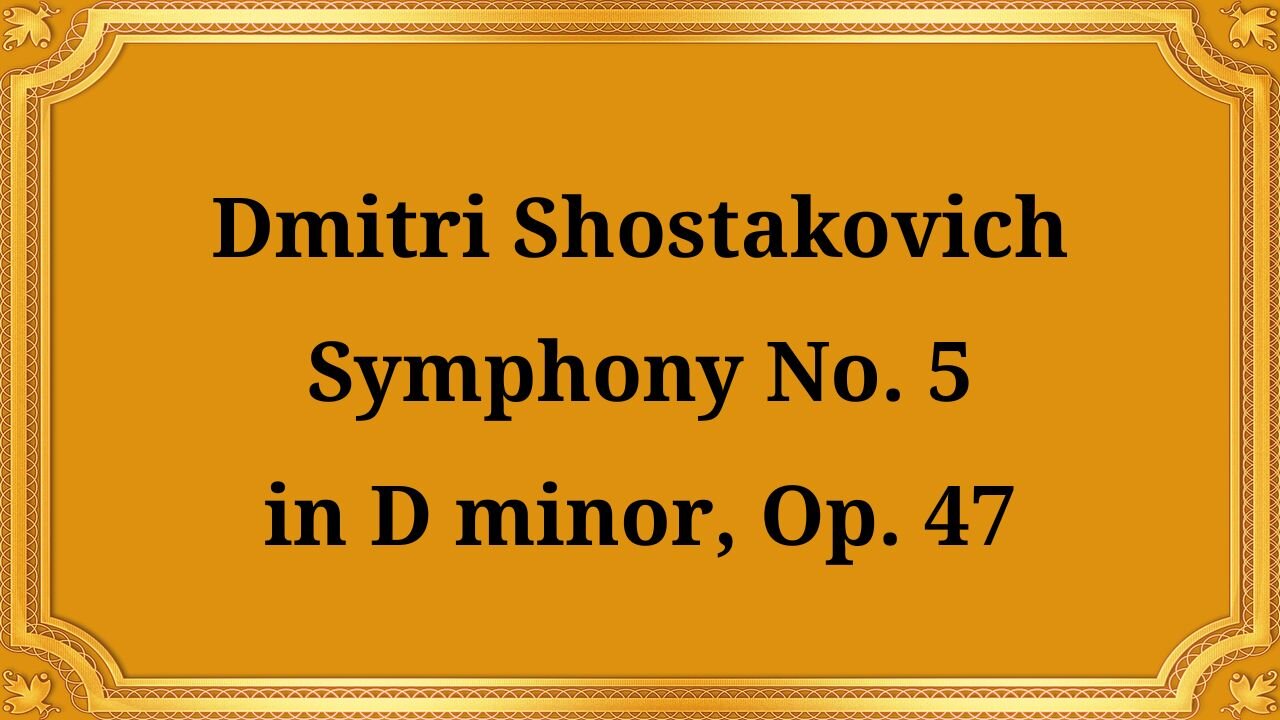Premium Only Content

Dmitri Shostakovich Symphony No. 5 in D minor, Op. 47
#Shostakovich #Symphony#5 #ClassicalMusic #20thCenturyMusic #SovietMusic
Recorded in 1952
Dimitri Mitropoulos (1896-1960) conducts the New York Philharmonic Symphony Orchestra (New York Philharmonic)
Dmitri Shostakovich's Symphony No. 5 in D minor, Op. 47, is one of the most significant symphonies of the 20th century. Written in 1937, it marked a turning point in Shostakovich's career after the Soviet authorities condemned his avant-garde opera Lady Macbeth of Mtsensk. The Fifth Symphony was subtitled "A Soviet Artist's Response to Fair Criticism," which allowed Shostakovich to regain favor with the Stalinist regime by subtly introducing layers of defiance and emotional depth.
The symphony follows a traditional four-movement structure, but is infused with Shostakovich's distinctive voice:
1. Moderato – Allegro non troppo 00:00
The first movement begins with a sharp, angular theme alternating between melancholy and aggression. It builds to a powerful march that reflects both struggle and resilience.
2. Allegretto 16:54
A schertz-like movement with grotesque, sardonic humor. A playful yet anxious character may parody Soviet bureaucracy or forced optimism.
3. Largo 22:08
A deeply emotional slow movement with lush string melodies and haunting solos. Often interpreted as a lament for the victims of Stalin's purges.
4. Allegro non troppo 36:40
The finale begins triumphantly but ends ambiguously - officially celebrated as a "positive" conclusion, the repeated, forced jubilation suggests irony and oppression.
Shostakovich composed the Fifth Symphony under enormous political pressure. The Soviet regime demanded accessible, "optimistic" music, and the apparent uniformity of the symphony allowed it to survive. However, many listeners detect an underlying dissent - especially in the empty victory of the finale. The composer later hinted in his memoirs (*Testimony*) that the symphony was about "forced joy".
The symphony premiered in Leningrad in 1937 and was an instant success, receiving recognition from both the authorities and the public. Today, it remains one of Shostakovich's most frequently performed works, admired for its emotional power and multi-layered meanings.
Dear listeners, you have the opportunity to support the channel:
https://t.me/rad_siar_al_bot
https://destream.net/live/RadSiarAl/donate
-
 24:35
24:35
Classical music_Music Inspiration
23 days agoMax Bruch Violin Concerto No. 1 in G minor, Op. 26
871 -
 14:47
14:47
GritsGG
1 day agoRumble Tournament Dubular! Rebirth Island Custom Tournament!
69.9K5 -
 1:36:05
1:36:05
Side Scrollers Podcast
19 hours agoStreamer ATTACKS Men Then Cries Victim + Pronoun Rant Anniversary + More | Side Scrollers
80.4K4 -
 LIVE
LIVE
Lofi Girl
2 years agoSynthwave Radio 🌌 - beats to chill/game to
245 watching -
 42:55
42:55
Stephen Gardner
1 day ago🔥Trump’s SURPRISE Move STUNS Everyone - Democrats PANIC!
102K122 -
 1:37:19
1:37:19
Badlands Media
16 hours agoBaseless Conspiracies Ep. 148: The Delphi Murders – Secrets, Setups, and Cover-Ups
47.1K17 -
 5:59:05
5:59:05
SpartakusLIVE
10 hours ago#1 MACHINE Never Stops The GRIND || LAST Stream UNTIL Friday
152K2 -
 28:36
28:36
Afshin Rattansi's Going Underground
1 day agoDoug Bandow: ENORMOUS DAMAGE Done to US’ Reputation Over Gaza, Trump ‘Easily Manipulated’ by Israel
33.4K32 -
 2:45:13
2:45:13
Barry Cunningham
16 hours agoCBS CAUGHT AGAIN! CHICAGO A MESS! LISA COOK IS COOKED AND MORE LABOR DAY NEWS!
122K51 -
 6:39:17
6:39:17
StevieTLIVE
10 hours agoMASSIVE Warzone Wins on Labor Day w/ Spartakus
37.9K1